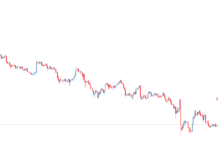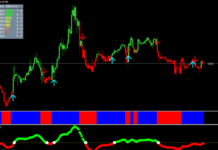ADX (Average Directional Movement Index) is a popular indicator that helps traders identify how strong and stable the current trend is. Introduced by a seasoned trader Welles Wilder, ADX is based on the other two of his tools, Positive Directional Indicator (+DI) and Negative Directional Indicator (-DI). To learn about Wilder’s interpretation of his invention, check out his book, New Concepts in Technical Trading Systems.
Before reading the article and writing your questions in the comments section, I recommend to watch this video. It’s not long but covers the biggest part of questions on the topic.
Table of Contents
About ADX

ADX is plotted as a single line, together with the +DI and -DI lines. Fluctuating from 0 to 100, these lines generate trading signals which we’ll cover below.
The +DI/-DI lines measure the strength of an uptrend/downtrend over a given period. If +DI is above –DI, the market is dominated by a bullish trend. If –DI is above +DI, we’re dealing with a bearish trend.
The ADX line is an exponential average of the –DI and +DI lines. It determines whether the market is trending (and if it is, how strong the trend is) or the price is moving sideways (goes flat). If ADX is rising and +DI and –DI are moving in the opposite direction, a strong trend is underway. If +DI and –DI are converging towards each other, the market is losing its momentum.
To start using ADX, you need to set up a few parameters.
First, you need to choose a period. Most traders prefer to use the default setting of 14. If you’re using an aggressive trading strategy, you can choose a shorter period to get more frequent signals. Keep in mind that many of these signals will be false. A longer period ensures lagging yet more accurate signals.
Another major ADX parameter is the “Apply to” option. Here you can choose the type of a price (high/how, close/open, average, etc.) you want to apply ADX too.
You can ignore the rest of the parameters as they won’t affect your trading in any significant way.
How to use ADX

As I’ve already mentioned, the ADX lines moves between 0 and 100. However, in real life, ADX hardly ever climbs above 60.
Readings between 20 and 40 indicate a weak trend. If ADX rises above 40 and keeps going up, you’re looking at a strong trend. While a rising ADX signals that the trend is gaining momentum, it says nothing about its direction.
A climbing +DI line may indicate an uptrend. If you see +DI and ADX rising at the same time, the trend is getting stronger. If ADX starts to slide down, the trend is losing momentum. A climbing –DI line indicates the occurrence of a downtrend. If this signal is confirmed by a rising ADX line, the downtrend is getting stronger.
These are the trading signals generated by ADX:
- ADX rises above 40;
- ADX falls below 20;
- –DI and +DI crossover.
The ADX line breaking out above 40 means the trend is strong enough to open a trade. If this movement is confirmed by a rising +DI line, you should go long. If –DI is rising, you should go short. You can also use other indicators to determine the direction of a trend. Many traders don’t wait for ADX to break the 40 level to open a trade. If ADX has been rising consistently, they open a trade once it has reached 30. To find out whether they are dealing with an uptrend or downtrend, traders look at the DI lines.
If the ADX line is meandering below 20, the market is not trending. This is good news for those trading within a certain price range. If –DI and +DI lines cross, the trend is changing its direction. If –DI crosses below +DI, an uptrend is reversing to a downtrend and you should go short. If –DI crosses above +DI, an uptrend is occurring and you should go long.

If the ADX line continues to rise above the other two lines, the trend is weakening. Opening a trade under such conditions is too risky. Furthermore, you should consider closing your current trades. If the ADX line is falling while staying above +DI and –DI, don’t think twice before closing your trades. And finally, the longer ADX stays below +DI and –DI, the stronger will be the next trend.
ADX and MACD
ADX is a helpful tool to identify a trend (or its absence) and its strength. It is often complemented with other technical indicators, especially the MACD oscillator. By combining these two tools, you can receive accurate information on how strong a trend is and where it is headed.
Regardless of whether the MACD line is rising or falling, you need a climbing ADX to confirm that a trend is getting stronger. If MACD is falling and ADX is continuing to rise, there is a divergence. While MACD shows that sellers are slowly taking over buyers, ADX confirms that a downtrend is getting stronger. This is an ideal timing to look for short trades.
Conclusion
There is a reason why ADX is rarely used on its own. The main problem with this indicator is that it generates lagging signals, i.e. the ADX line is starting to rise after a trend has already started.
As a result, a trader misses some great entry opportunities. Lagging is typical for many modern technical tools and can only be avoided by using additional indicators as confirmation.
ADX is neither a classic oscillator nor a classic trend indicator. It’s an easy-to-use instrument to get a perspective on trending conditions and choose the best trading strategy. Although not a multi-purpose tool, the Wilder’s invention is a surefire way to identify a strong trend.






hey man thanks alot for this!
What is the winning probability of a signal using the adx/dmi?
The indicators are just here as a guide to avert catastrophes during trading, the market is controlled by a whole lot of factors that one “Magic indicator” can not show.But at least let us give the credits to the gurus for making this available and FREE..
he problem with most indicators is that they are late because they are derived from past movements of price. I like a slow stochastic because it shows overbought and oversold conditions.
Nice presentation on this indicator
Good overview and explanation of ADX
Use ADX with MacD and RSI indicator, and your chances of making profit will increase dramatically!!..
sir i have a question what’s the best time frame to trade for a newbie like me?
ADX – a very good indicator. Not only do I use it as one of my indicators to get into a trade. I also use it to tell me when I could be getting into trouble. I don’t use it for anything but trend strength and possible reversal indicator.